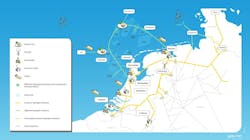Gasunie investigates hydrogen network in North Sea
GRONINGEN, The Netherlands — In the area of hydrogen production, the Netherlands has a sizeable climate target to meet, according to energy network operator Gasunie. The North Sea offers opportunities for generating the required green energy through wind farms.
Werna Udding, responsible for offshore hydrogen at Gasunie, said, "We are already working on the national hydrogen network on land. And now, together with other parties, we are also investigating the possibilities of creating an offshore hydrogen network."
Green hydrogen will play an important role in the energy transition. It will be used to help to make industry and heavy transport more sustainable, for example, and will serve as a feedstock for the chemical industry.
"It’s with this in mind that the Netherlands has set itself an ambitious target for the production of hydrogen: 4 gigawatts in 2030—and we are even thinking about doubling that target figure," Werna said.
Internationally, the bar is set even higher, Gasunie reported. Last summer, the Netherlands signed the Esbjerg Declaration with Denmark, Germany and Belgium, in which they have agreed to develop the North Sea as a "green power plant." By 2030, they want to produce 65 GW of offshore wind power, 20 GW of which is earmarked for the production of green hydrogen.
Werna believes that could be even more, stating, "Minister Jetten (Climate and Energy Policy) has commissioned research into seeing whether 70 GW of offshore wind energy can be realized by 2050."
Scope for large-scale power generation
Green hydrogen is made with solar and wind energy. In the Dutch hydrogen plans, the energy for this mainly comes from offshore wind farms. Along the Dutch continental shelf in the North Sea, Gasunie says there is potential for large-scale generation of the required energy. In the plans up to 2030, the electricity from the future wind farms will mainly come ashore through cables. Once ashore it can be converted into green hydrogen at electrolysis plants.
Producing hydrogen offshore
Laying power cables is an expensive operation, even more so for the wind farms that will be built farther off the coast in the coming years. The Dutch government estimates the investment costs for the offshore cable network to be about 26 billion euros. Partly for this reason, offshore electrolysis, close to the power source, is now also being considered. Instead of first bringing the electricity ashore through an expensive cable, this power would be used to produce hydrogen on site. This hydrogen would then be transported to the mainland through pipelines. Not only is laying an offshore pipeline many times cheaper than laying a cable, more energy can be transported through in one go too.
Werna said, "One large pipeline can supply 10 to 20 gigawatts. By comparison, you would have to lay five to 10 power cables to accomplish the same."
This also has advantages in terms of having a smaller physical footprint. Research has shown that offshore hydrogen production results in lower social costs than large-scale onshore electrolysis.
Hydrogen network for transport to shore
Werna and her team are investigating the possibilities of laying an offshore hydrogen network.
She added, "What requirements should it meet, what should it cost, where can and should it come ashore? But we are also looking at the entire system into which the infrastructure must fit: how much of the wind energy do we want to use to produce hydrogen? There are also questions about regulations and instruments. None of this is clear yet."
Werna sees the benefits of Gasunie potentially creating an offshore hydrogen network. Gasunie is already developing the onshore hydrogen network in the Netherlands. The Ministry of Economic Affairs and Climate Policy commissioned this work after research showed that a good 85% of the existing gas pipeline network can safely be used for the transmission of hydrogen, Gasunie reported.
Werna said, "We can provide a transmission network that everyone can connect to, so that each wind farm does not have to be connected to shore separately. What’s more, this way you create a system that connects directly to the onshore hydrogen infrastructure."
Start right away
The electrolysis projects so far are all being carried out on land. The technology of producing hydrogen at sea is in its infancy.
"The first larger pilots and projects could be operational in 2028 or 2029," Werna said. "Preparations for that need to start right now. That means we also need to get started soon with the development of the offshore hydrogen network so that it is ready in time to bring the hydrogen produced at sea ashore."
Public or private
The government will determine whether hydrogen will eventually be transported through a private or public network. It should soon become clear who will be allowed to develop the offshore hydrogen network. According to Werna, Gasunie is ready.
"We have knowledge and experience," Werna concluded. "If you take a smart approach, you will have built the infrastructure that will last many years in one go, also with connections to other countries. And to the storage facilities, too, for additional flexibility in our energy supply. With such an approach, we will be primed to welcome a green energy system."
Article by Gasunie
10.12.2022
